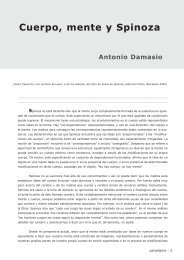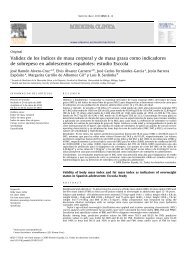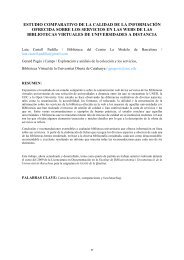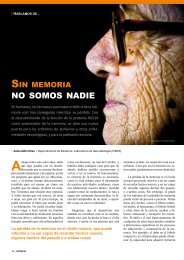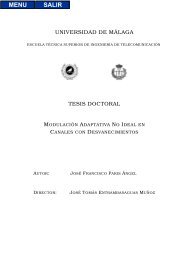Estereotipos negativos hacia la vejez y su relación con variables ...
Estereotipos negativos hacia la vejez y su relación con variables ...
Estereotipos negativos hacia la vejez y su relación con variables ...
Create successful ePaper yourself
Turn your PDF publications into a flip-book with our unique Google optimized e-Paper software.
Referencias<br />
Schweizer, K., Beck-Seyffer, A. y Scheider, R. (1999). Cognitive bias of optimism and its influence<br />
on psychological well-being. Psychological Reports, 84(2), 627-636.<br />
Schwiebert, D. C. (1978). Unfavorable stereotyping of the aged as a function of death anxiety, sex,<br />
perception of elderly re<strong>la</strong>tives, and a death anxiety-repression interaction. Dissertation<br />
Abstracts International, 39(6b), 3007.<br />
Scioli, A., Chamberlin, C. et al. (1997). A Prospective Study of Hope, Optimism and Health.<br />
Psychological Reports, 81(3, pt 1), 723- 733.<br />
Seccombe, K. e Ihsii-Kuntz, M. (1991). Perceptions of problems associatted with aging: Comparisons<br />
among four older age cohorts. The Gerontologist, 31(4), 527-533.<br />
Secord, P. .F. y Backman, C. W. (1974). Social Psychology. New York: McGraw-Hill.<br />
Seefedlt, C., Jantz, R. K., Calper, A. y Serok, K. (1981). Healthy, happy, and old: Children learn about<br />
the elderly. Educational Gerontology, 12, 151- 158.<br />
Seefedlt, C. (1987). The effects of preschoolers´ visits to a nursing home. Gerontologist, 27, 228-232.<br />
Seeman, T., Unger, J., McAvay, G. y Mendes de Leon, C. (1999). Self efficacy beliefs and perceived<br />
declines in functional ability: MacArthur studies of <strong>su</strong>ccessful aging. Journal of Gerontology:<br />
Psychological Sciences, 54B, 214-222.<br />
Serra, E. (1990). El envejecimiento como proceso. Revista de Psicología de <strong>la</strong> Educación, 2(4), 7-13.<br />
Settersten, R. y Mayer, K. (1997). The mea<strong>su</strong>rement of age, age structuring and the life course. Annual<br />
Review of Sociology, 23, 233-261.<br />
Setting, J. M. (1982). Clinical judgement in geropsychology practice. Psychoperapy: Theory,<br />
Research and Practice, 19, 397- 404.<br />
Sharpe, P., Hickey, T. y Fredric, M. (1994). Adaptation of a general optimism scale for use whit older<br />
women. Psychological Reports, 74(3), 931-937.<br />
Sharples, L. D., Todd, C. J., Caine, N. y Tait, S. (2000). Mea<strong>su</strong>rement properties of the Nottinghan<br />
Health Profile and Short Form 36 health status mea<strong>su</strong>res in a popu<strong>la</strong>tion sample of elderly<br />
people living at home: Re<strong>su</strong>lts from ELPHS. British Journal of Health Psychology, 5(Part3),<br />
217-233.<br />
Shea, G. F. (1991). Managins older employees. San Francisco: Jossey-Bass.<br />
Shih, M., Pittinsky, T. L. y Ambady, N., (1999). Stereotype <strong>su</strong>sceptibility: Identity salience and shifts<br />
in quantitative performance. Psychological Science, 10(1), 80-83.<br />
Shih, M., Ambady, N., Richeson, J., Fujita, K. y Gray, H. (2002). Stereotype Performance Boost: The<br />
impact of self-relevance and the manner of stereotype activation. Journal of Personality and<br />
Social Psychology, 83(3), 638-647.<br />
Shiffrin, R. M. y Schneider, W. (1977). Controlled and automatic human information processing: II.<br />
Percepctual learning automatic attending and a general theory. Psychological Review, 184,<br />
127- 190.<br />
252




